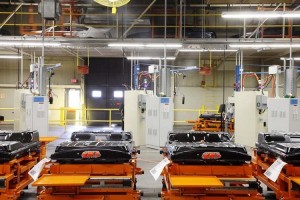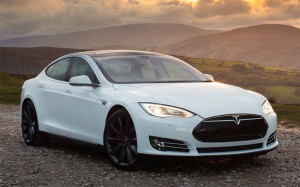
The biggest problem with battery cars? The batteries -- shown here being assembled at a Nissan plant.
The biggest problem with today’s battery cars? The batteries, of course, which simply can’t deliver enough power in a compact, reasonably lightweight package.
A California-based initiative is aimed at “turbocharging the innovation process,” explained a senior official, looking for ways to boost power, drop costs and extend battery life. The project, dubbed CalCharge, has added six new partners, including major players like the Japanese auto giant Toyota and German mega-supplier Bosch. In all, 18 automakers, parts suppliers and energy companies have joined the initiative – which has also teamed up with a number of national research labs.
“Connecting private companies with the talent at the labs means that innovators at both public and private organizations have a new opportunity to learn and share with one another,” said Horst Simon, deputy director at Berkeley Lab, one of the founding organizations of CalCharge.
The addition of more partners, Simon added, should help the CarCharge initiative “move closer to meaningful breakthroughs in battery technology.”
(When “Insane Mode” isn’t enough. Tesla adding new “Luuudicrous Mode” for Model S. Click Here for more.)
CalCharge pairs companies with three Bay Area national labs: Lawrence Berkeley National Laboratory, SLAC National Accelerator Laboratory and Lawrence Livermore National Laboratory.
“Gaining access to the national labs, their experts and unique facilities means we can accelerate our innovation efforts,” said Aleksandar Kojic, department head in corporate research at Bosch.
The CalCharge CRADAs, or Collaborative Research and Development Agreements, helps national labs, funded by the Department of Energy, find and work with pioneering companies.
“The CalCharge CRADA has enabled SLAC to quickly engage with industry partners in helping to advance their battery technology,” said Mark Hartney, chief technology officer at SLAC. “Through CalCharge, SLAC is furthering the Department of Energy’s stated strategy of helping private industry accelerate their technology development in collaboration with the national labs.”
(Click Here to check out the newly updated version of the Lexus ES 300h hybrid.)
Battery-based vehicles have been slower to catch on than proponents had hoped. Cost is a major issue, both for consumers, as well as automakers who often have to subsidize their plug-in and battery-electric vehicles to bring them within the reach of buyers. Limited range is a second major challenge. The industry also needs to be sure that batteries will last long enough to satisfy consumers who might otherwise be saddled with expensive replacement costs.
“Being able to store energy efficiently, affordably and at the right scale is the key to unleashing the full power of the clean energy economy,” said Julie Blunden, chair of the CalCharge board, who suggested that, “By bringing national labs and cutting-edge companies together, CalCharge is turbocharging the innovation process (which) brings breakthroughs that much closer to the marketplace.”
California is considered a leader in the energy storage sector, with over one hundred companies working to advance battery technology.
“What happens in the California energy sector shapes the entire industry,” said Dr. Mohan Misra, founder, president and CEO of ITN Energy Systems, a technology incubator focused on developing next generation flow batteries, lithium-ion batteries and fuel cells.
(Panasonic will help Tesla launch its new gigafactory, Click Here for more.)


Helpful piece, Joe. Thanks.
IMO this is throwing money at the wrong technology when hydrogen fuel cells are far more practical. If all concerned parties were to promote the building of hydrogen refueling facilities and vehicles, then we’d have the best of both worlds. Bosch and other suppliers however are geared towards electrical products and as such prefer battery powered EVs instead of superior hydrogen powered vehicles.
When you look at the cradle to grave process of a toxic battery vs. hydrogen gas production, it’s quite obvious that hydrogen is the far better choice for the planet. That of course does not mean government and commercial interests will promote the best option when lobbyists like Tesla and others pander to politicians who routinely dupe the gullible public and throw tax payer money at charlatans who’s entire business model for multiple companies is based on U.S. tax payer paid grants and subsidies. These schemes are just like the gasohol scam currently being perpetuated for the huge financial benefit of a very small group of people.
Good article. I like electric battery cars. There is no toxicity with automotive battery as the recycling rate is 99.5 % lithium will be the same. But what is thebest part by having a solar house and electric car is one fills it up a home. Try that with hydrogen or if they ever reduce to cost to have one at home. Bob Lutzs was equally confused about filling up your electric car at home with solar. Oh well some peoplejust love being a corporate slave and tied to economic shifts.7
You are misinformed. Not only are the EV batteries toxic during construction they are toxic during recycling. The fire hazards are well documented before, during and after an accident. They can burn your EV and house down. Tesla can attest to these facts. Ask NHTSA.
See superhalogens for info. on the toxicity of Li-ion batteries. The meth labs even use some of the battery materials to cut the illicit drugs. That’s a useful recycling activity…
Somebody should go play with a can of gas and matches. Then talk about hazards
It sound like some folks get testy when the facts are disclosed. LOL
Voodoo facts